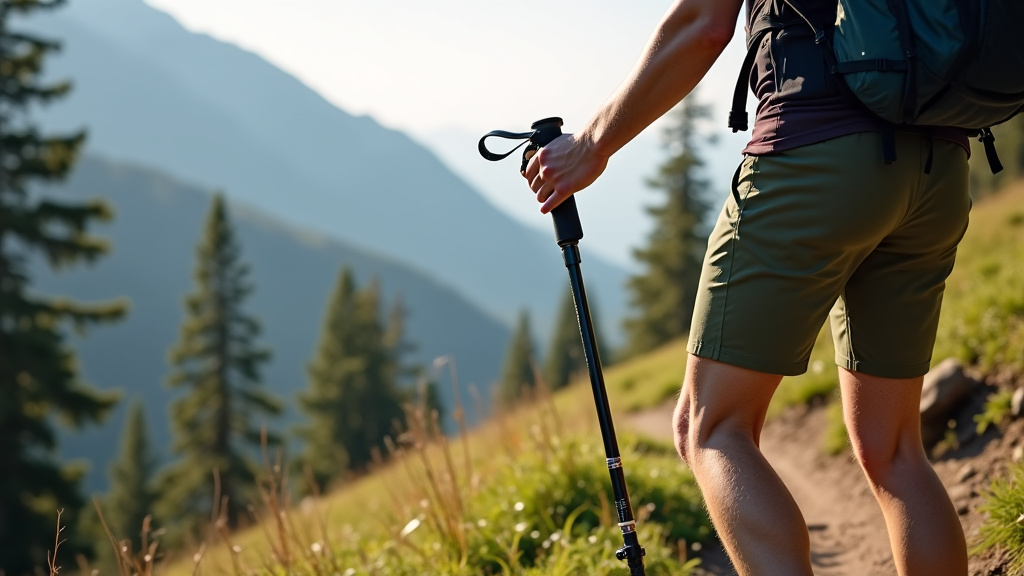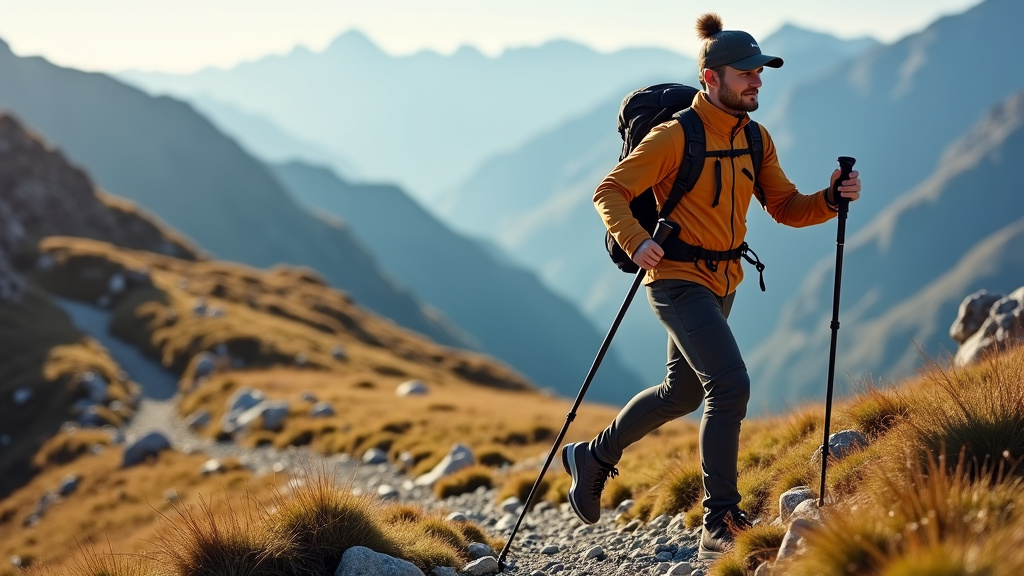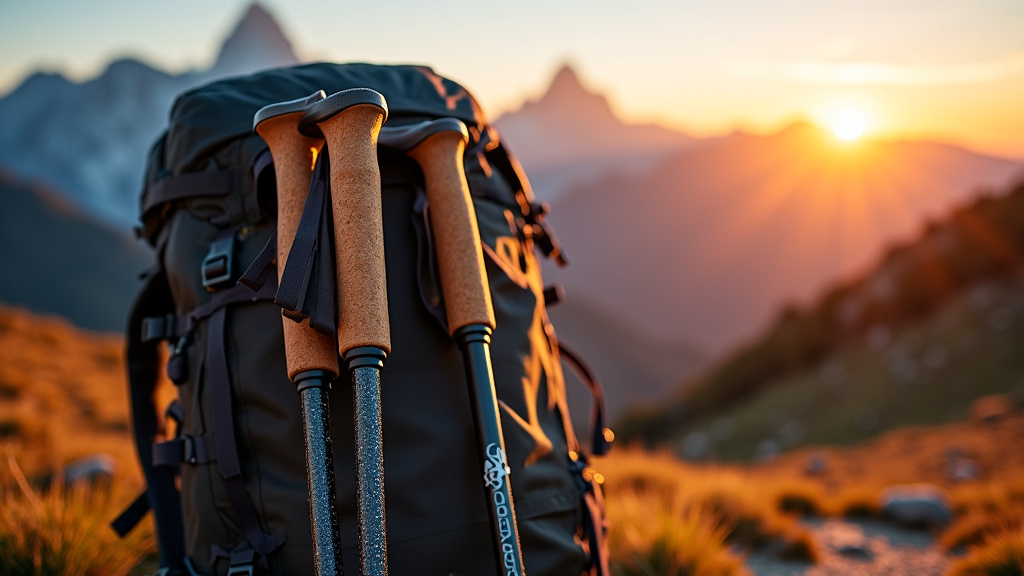Picture yourself confidently navigating a steep mountain trail, your steps steady and assured thanks to the perfect pair of hiking poles. For hikers seeking to enhance their outdoor experience, quality trekking poles have become essential companions on the trail.
I’ve personally witnessed how the right pair of hiking poles can transform a challenging trek into an enjoyable journey. These versatile tools reduce impact forces on your knees by up to 40% during steep descents, while providing the stability needed to tackle technical terrain with confidence.
As a recent study shows, trekking poles help maintain greater muscle function and reduce soreness by engaging your upper body in the hiking motion. This full-body approach enhances performance and helps prevent injuries on long-distance adventures.
Gone are the days when hiking poles were considered optional accessories. Whether you’re a weekend warrior hitting local trails or planning an ambitious thru-hike, the right pair of poles can transform an exhausting trek into an invigorating outdoor experience.
Benefits of Using Hiking Poles for Men

Science has shown what experienced hikers have known for years – trekking poles are far more than just accessories. A landmark 2010 study from the UK’s Northumbria University demonstrated that hikers using poles experienced 25% less muscle fatigue and damage compared to those hiking without them.
These essential tools can enhance your hiking experience and help protect your body for years of outdoor adventures.
Reduced Joint Impact and Injury Prevention
The primary benefit of hiking poles is their ability to protect your joints. Research shows that poles can reduce the force on your knees and other joints by up to 25%, particularly during challenging descents.
By distributing your body weight across four points of contact instead of just two, poles significantly decrease the impact forces that your knees, hips, and ankles must absorb with each step.
| Benefit | Description |
|---|---|
| Reduced Joint Impact | Using poles distributes body weight across four limbs instead of two, reducing strain on knees and hips, especially during descents. |
| Improved Stability | Poles provide additional points of contact with the ground, enhancing balance and stability on uneven terrains. |
| Enhanced Endurance | Engaging the upper body reduces workload on legs, allowing for longer hikes with less fatigue. |
| Muscle and Cartilage Protection | Poles can reduce muscle and cartilage damage during downhill walking by reducing lower limb joint forces by up to 25%. |
The stabilizing effect is particularly valuable when carrying a heavy backpack or traversing technical terrain where joint strain is highest.
Enhanced Balance and Stability
Consider hiking poles as additional support points for your body. They create extra ground contact, significantly improving your stability on uneven terrain.
This enhanced stability proves essential when crossing streams, navigating slippery surfaces, or traversing steep slopes where a single misstep could lead to injury.
Improved Posture and Breathing
The natural arm swing that comes with proper pole use helps maintain an upright posture while hiking. This improved alignment allows your rib cage to fully expand, optimizing your breathing capacity.
Better posture also reduces strain on your back and neck muscles, particularly important when carrying a loaded backpack on long treks.
Increased Endurance and Full-Body Engagement
Using hiking poles transforms your hike into a full-body workout by actively engaging your upper body muscles. While this may slightly increase calorie burn, it distributes the workload more evenly across your muscle groups.
This balanced effort helps prevent any single muscle group from becoming overly fatigued, allowing you to hike longer distances with less exhaustion.
Choosing the Right Hiking Poles: Materials and Design
Selecting the perfect hiking poles can make the difference between an enjoyable trek and a challenging ordeal. I’ve tested dozens of poles over the years, and I’ll share what I’ve learned about the crucial features that make certain poles stand out from the rest.
Let me start with a compelling fact: using trekking poles can reduce impact force on your knees by up to 40%, especially during long descents. This reduction makes a significant difference in preserving your joints over years of hiking.
The Great Debate: Aluminum vs. Carbon Fiber
Having used both materials extensively, I can tell you that aluminum poles are the workhorses of the hiking world. They’re incredibly durable and, if bent, can often be reshaped rather than breaking completely.
Carbon fiber poles, while lighter and more responsive, have their own advantages. As noted in a comprehensive by Cascade Mountain Tech, carbon fiber poles excel in providing immediate support with minimal vibration.
Here’s what fascinates me about carbon fiber: it’s incredibly strong when bearing weight vertically, but it can be vulnerable to side impacts. I’ve witnessed this firsthand on rocky terrain.
Grip Materials: Your Point of Contact
The grip material you choose dramatically affects your hiking experience. Cork handles have become my personal favorite after countless miles on the trail. They naturally mold to your hand shape and maintain their grip even when your palms get sweaty.
Foam grips offer excellent moisture-wicking properties and are remarkably lightweight. I’ve found them particularly useful during summer hikes when keeping your hands cool becomes crucial.
Rubber grips, while less common, excel in cold weather conditions. They provide better insulation and maintain their tactile feel even when you’re wearing gloves.
Locking Mechanisms and Adjustability
Through my experience leading hiking groups, I’ve noticed that lever locks tend to be more reliable than twist locks. They’re easier to adjust with cold or wet hands, and you can visually confirm they’re secured.
The ability to adjust your pole length isn’t just a convenience—it’s a necessity when tackling varied terrain. I typically adjust mine shorter for uphill sections and longer for descents.
Remember, the best hiking poles are the ones that match your specific needs and hiking style. Consider factors like your typical terrain, weather conditions, and whether you’ll be using them for multiple activities like snowshoeing or backpacking.
Proper Sizing and Adjustment Techniques for Men

Finding the perfect hiking pole length might seem daunting at first, but I’ve spent years helping outdoor enthusiasts dial in their ideal fit. Let me guide you through the proven process that has worked for thousands of hikers.
The fundamental rule for sizing hiking poles is achieving a 90-degree bend in your elbow when gripping the pole with its tip planted near your foot. This position provides optimal leverage and comfort for most terrain types.
Here’s a reliable sizing guideline: multiply your height in centimeters by 0.68. For instance, if you’re 180cm tall, you’d want poles around 122cm in length. Consider this a starting point for your adjustments.
| Your Height (ft in) | Your Height (cm) | Suggested Pole Section Length (cm) |
|---|---|---|
| 4’0″ | 122 | 85 |
| 4’2″ | 127 | 90 |
| 4’4″ | 132 | 90 |
| 4’6″ | 137 | 95 |
| 4’8″ | 142 | 100 |
| 4’10” | 147 | 100 |
| 5’0″ | 152 | 105 |
| 5’2″ | 157 | 110 |
| 5’4″ | 163 | 115 |
| 5’6″ | 168 | 115 |
| 5’8″ | 173 | 120 |
| 5’10″ | 178 | 125 |
| 6’0″ | 183 | 125 |
| 6’2″ | 188 | 130 |
| 6’4″ | 193 | 135 |
Basic Sizing and Initial Setup
Getting the basic fit right starts with standing naturally on level ground. Hold the pole with its tip beside your foot, and adjust until your forearm is parallel to the ground – this establishes your baseline setting.
For those with particularly long legs relative to their height (common among basketball players and runners), slightly longer poles may be preferable. The tip of your upturned thumb often provides a better gauge than the standard palm measurement.
When using adjustable poles, which I highly recommend for beginners, start by extending the lower section first. As noted in a comprehensive study by REI’s hiking experts, this provides better stability and easier adjustments on the trail.
Terrain-Specific Adjustments
Through countless mountain ascents, I’ve learned that pole length requires ongoing adjustment based on the terrain ahead.
For uphill sections, shorten your poles by 5-10cm. This adjustment provides better pushing power and prevents overreaching – a common mistake among novice hikers. Your shoulders should remain relaxed, never strained or lifted.
When heading downhill, lengthen your poles by 5-10cm from your baseline setting. This helps maintain an upright posture and reduces knee strain, particularly beneficial on long descents.
Fine-Tuning for Comfort
Years of guiding experience have shown that comfort depends on precise adjustments. Keep your wrist position neutral, avoiding awkward angles.
The pole’s grip should align comfortably at hip level when standing straight. Any shoulder tension during normal use indicates your poles need adjustment.
For traversing slopes, here’s a proven technique: shorten the uphill pole and lengthen the downhill pole slightly. This adjustment naturally accommodates the terrain angle while maintaining proper form.
Top Hiking Pole Features for Men
Modern trekking poles incorporate advanced features that enhance your hiking experience. Here are the key technologies and design elements that make today’s hiking poles more effective and versatile.
Advanced Shock Absorption Systems
One of the most crucial features in premium trekking poles is anti-shock technology. The Black Diamond Distance Carbon Z poles utilize a dynamic suspension system that absorbs impact, reducing strain on your joints during long descents.
These shock absorption systems employ a spring-loaded mechanism that compresses with each strike, protecting your wrists and elbows from repetitive impact on hard surfaces.
The dampening effect excels on rocky terrain, where the poles maintain stability while minimizing vibration transfer to your hands.
Versatile Terrain Adaptability
Modern poles feature interchangeable baskets designed for specific terrain types. Standard trekking baskets prevent poles from sinking in soft ground, while wider snow baskets provide essential support in winter conditions.
The carbide tips deliver exceptional grip on most surfaces, and many models include rubber tip covers for sensitive terrain or pavement. This adaptability ensures proper equipment for any trail condition.
Ergonomic Grip Technology
Premium cork and EVA foam grips are engineered to fit men’s hand dimensions. These materials wick away moisture and conform to your grip pattern over time, creating a custom fit that reduces hand fatigue.
Extended grip sections below the main handle enable quick hand position adjustments on steep terrain without stopping to resize the poles – an invaluable feature when traversing varied landscapes.
Advanced Folding Mechanisms
Modern pole designs feature sophisticated folding systems for compact storage without compromising stability. The LEKI Makalu FX Carbon poles include a precision folding mechanism that collapses to 16 inches while maintaining exceptional rigidity when extended.
These folding designs simplify pole attachment to packs and storage in luggage while preserving performance and durability.
Weight-Optimized Materials
Carbon fiber construction enhances trekking pole design with superior strength and reduced weight. These ultralight materials prevent arm fatigue during long hikes while maintaining durability.
Strategic reinforcement at stress points ensures these lightweight poles handle technical terrain and heavy loads effectively, serving well for both day hikes and extended backpacking trips.
| Brand | Model | Price | Weight (Pair) | Shaft Material | Grip Material | Collapsed Length |
|---|---|---|---|---|---|---|
| Black Diamond | Pursuit | $150 | 1 lb. 0.4 oz. | Aluminum | Cork | 22.8 in. |
| Gossamer Gear | LT5 | $195 | 10.6 oz. | Carbon Fiber | Foam | 23.5 in. |
| Montem | Ultra Strong | $75 | 1 lb. 3.2 oz. | Aluminum | Foam | 24 in. |
| LEKI | Makalu Cork Lite | $150 | 1 lb. 2 oz. | Aluminum | Cork | 26.3 in. |
| REI | Flash Carbon | $169 | 13.6 oz. | Carbon Fiber & Aluminum | Foam | 25 in. |
Hiking Pole Techniques and Best Practices for Men

Mastering proper hiking pole technique transforms these essential tools into powerful allies for any outdoor adventure. When used correctly, trekking poles reduce knee strain by up to 25% while enhancing balance and momentum across varying terrains.
The effectiveness of hiking poles extends beyond simply carrying them – proper form and rhythm are crucial. Consider them extensions of your arms, working in harmony with your natural walking motion.
Here are the fundamental techniques to maximize their benefits and enhance your hiking experience.
Mastering the Basic Nordic Walking Technique
The most efficient hiking pole technique derives from Nordic walking, developed by Scandinavian skiers for summer training. Plant your poles at a 45-degree angle behind you and actively push to engage your entire upper body.
When walking, coordinate your poles with opposite legs – right pole with left foot, left pole with right foot. This creates a natural, flowing rhythm that propels you forward while distributing effort across your body.
For optimal power transfer, thread your hand up through the strap from underneath, then grip both the strap and handle. This technique secures your hand to the pole, allowing for better control and reduced fatigue.
Adapting Technique for Different Terrains
Steep uphills require shorter pole lengths and a more aggressive forward plant. According to experienced guides, shortening your poles by 5-10 centimeters provides better leverage and support without straining your shoulders.
For downhill sections, lengthen your poles slightly to help absorb impact and maintain balance. Plant them firmly in front of you, using them as brakes to reduce knee strain and maintain controlled descent.
On flat terrain, focus on the pushing motion behind you rather than planting poles in front, as forward planting can impede progress. Maintain a consistent rhythm to optimize walking efficiency.
Advanced Techniques for Challenging Conditions
For river crossings, use your poles to test water depth and current strength before stepping. Plant them firmly on the upstream side of your body to create a stable tripod effect as you move across.
In deep snow or mud, attach wider baskets to your poles to prevent excessive sinking. The wider surface area provides better support and helps maintain your walking rhythm.
For extremely steep or technical terrain, employ the double-pole planting technique. Place both poles in front of you, take two steps, then repeat. This method ensures at least three points of contact with the ground at all times.
| Terrain Type | Recommended Adjustment |
|---|---|
| Flat/Rolling Terrain | Set poles so arms are at a 90-degree angle |
| Uphill | Shorten poles by 5-10 cm |
| Downhill | Lengthen poles by 5-10 cm |
| Traversing | Shorten uphill pole, lengthen downhill pole |
Maintenance and Care Tips for Hiking Poles
Proper maintenance of your hiking poles ensures reliable performance when you need it most on challenging trails. Drawing from years of experience maintaining equipment at outdoor gear shops, I’ve identified the essential care techniques that truly matter.
These proven maintenance methods will keep your poles performing optimally. Regular cleaning and seasonal checks prevent the common issues that affect neglected hiking poles.
Learn to identify early warning signs of wear and tear to prevent equipment failures on the trail. Here’s how to maintain your trusted hiking companions in peak condition.
Essential Cleaning and Drying Procedures
After each hike, take time to clean your poles thoroughly with a moist towel. Remove dirt, mud, and debris that could cause corrosion or mechanism failure.
For telescoping poles, separate the sections and wipe down each segment individually. This prevents trapped moisture inside the tubes, which can lead to internal oxidation and eventual failure of the locking mechanisms.
Allow your poles to dry completely before storing them. Never store them wet, as this leads to rust formation and deterioration of both metal and plastic components.
Lubricating Moving Parts for Smooth Operation
Regular lubrication of moving parts is crucial for maintaining smooth adjustment and preventing wear. Focus on the locking mechanisms, joints, and threaded components.
Apply a light coating of lubricant to every screw and moving component monthly. This prevents rust formation and ensures smooth operation of adjustment mechanisms.
Avoid over-lubrication, as excess oil or grease attracts dirt and creates an abrasive paste that accelerates wear. A thin layer suffices.
Replacing Worn Components
Monitor your poles’ tips regularly for signs of wear. Replace rounded or worn carbide tips immediately – they can slip on rocky surfaces, creating a safety hazard.
Check baskets and straps periodically. These components typically wear out before the poles themselves and require replacement when showing significant wear or damage.
Pay special attention to locking mechanisms, especially on telescoping poles. Replace these critical components if they become difficult to adjust or fail to hold firmly.
Proper Storage Techniques
Store your poles in a dry, temperature-controlled environment. Extreme temperatures can affect materials and compromise structural integrity.
For extended storage, keep poles collapsed with locking mechanisms slightly loosened. This reduces component stress and prevents seizing.
Use a dedicated storage bag to protect against dust and damage while keeping accessories organized.
| Technique | Advantages | Disadvantages |
|---|---|---|
| Bulk Storage | Cost-effective, reduces handling, allows for online filtration | High upfront costs, risk of leakage |
| Totes | Allows filtration, eliminates empty drums | Requires proper management to avoid contamination |
| Drums | Commonly used, can be properly stored indoors | High risk of contamination if not managed properly |
Conclusion: Elevate Your Hiking Experience with the Right Poles

Trekking poles have become an indispensable companion for serious hikers and outdoor enthusiasts. When properly selected and used, these versatile tools can reduce impact force on your knees by up to 40%, particularly during challenging descents that shape memorable adventures.
I’ve found that investing in quality poles pays dividends in both comfort and reliability. Premium poles feature ergonomic cork grips that mold to your hands over time, sturdy aluminum or carbon fiber construction, and dependable locking mechanisms that remain secure when you need them most.
Through extensive testing of various models in demanding conditions, I’ve learned that the right poles offer far more than stability. They establish a natural rhythm on long treks, distribute weight evenly across your body, and provide crucial confidence when crossing streams or traversing steep terrain.
While budget-friendly options exist, I strongly recommend viewing trekking poles as a long-term investment in your hiking enjoyment and joint health. A quality pair from a reputable manufacturer like Black Diamond or Leki will serve you reliably for years of adventures.
Your specific hiking style and terrain preferences should guide your choice between ultralight carbon fiber poles for fast-paced treks or more robust aluminum models for heavy pack loads and technical terrain. The key is selecting tools that match your individual needs.







